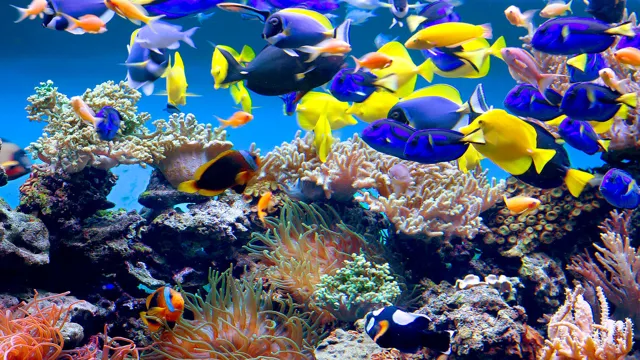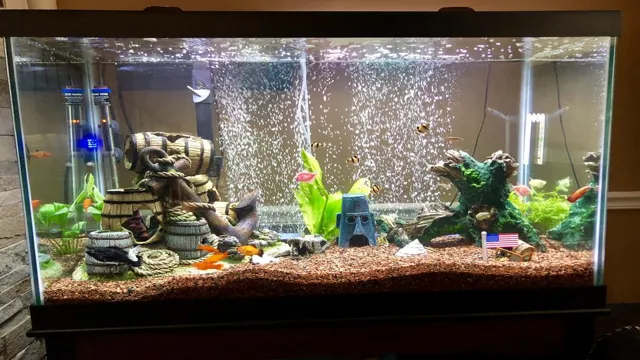Maintaining a balanced pH level in your aquarium is crucial to ensuring the health and wellbeing of your fish and other aquatic creatures. But what exactly is pH, and why is it so important? pH is essentially a measure of how acidic or alkaline the water in your aquarium is, and different fish species have different pH level requirements. For example, some species prefer acidic water, while others thrive in alkaline environments.
So, if the pH level in your aquarium is not within the ideal range for your fish, it can lead to a host of issues such as stress, disease, and even death. In this blog, we’ll share some tips on how to maintain a balanced pH level in your aquarium so that your fish and other aquatic creatures can live long and happy lives.
Understanding PH Balance in an Aquarium
Keeping a good pH balance in your aquarium is essential to the health and wellbeing of your aquatic friends. The pH level measures the acidity or alkalinity of the water, and an imbalance can cause stress, illness, and ultimately death for your fish. Many factors can affect pH levels, such as tap water quality, fish waste, and the use of chemicals or treatments in the tank.
To maintain the ideal pH range, which varies depending on the type of fish, it’s essential to test the water regularly and make adjustments as needed. You can add chemicals or natural elements, such as limestone or driftwood, to adjust the pH levels. Additionally, changing the water regularly can help keep the pH balanced.
Remember that sudden changes in pH levels can also be harmful, so it’s crucial to monitor and adjust slowly over time. By understanding the importance of pH levels and making adjustments as needed, you can ensure a happy and healthy environment for your aquatic pets.
What is PH Balance?
PH balance is a crucial aspect of maintaining a healthy aquarium environment for your fish and other aquatic creatures. Simply put, PH measures the level of acidity or alkalinity in the water, with a scale ranging from 0 to 1 A neutral PH level is 7, while anything below 7 is considered acidic and anything above 7 is alkaline.
For most fish, the ideal PH level typically falls between 5 and
However, the PH needs of specific species may vary and require more attention to maintain a healthy ecosystem in the tank. To ensure your aquarium has the correct PH balance, you can use testing kits to regularly check the PH levels and make adjustments as needed. Additionally, using treatments such as buffers or peat moss can help stabilize PH levels.
By understanding how PH balance works and taking the necessary steps to maintain it, you can provide a healthy and thriving environment for your aquatic pets.

Why is PH Balance Important in an Aquarium?
PH balance is a vital aspect of maintaining a healthy and thriving aquarium environment. In simple terms, PH is a measure of acidity or alkalinity, and it is measured on a scale of 0-1 A neutral PH is
0, and anything below it is considered acidic, while anything above it is considered alkaline. Most aquariums require a PH range between 5 to
0 to support aquatic life. Maintaining this balance is crucial because it directly affects the health of your fish, plants, and other aquarium inhabitants. A proper PH balance ensures the water supports the survival of beneficial bacteria while also preventing the buildup of harmful toxins that are harmful to aquatic life.
Factors that can influence PH balance in an aquarium include substrate composition, the type of decorations used, and the type of fish and plants living within it. Therefore, it’s essential to regularly test the water’s PH and make any necessary adjustments using appropriate PH balancing products. Ultimately, understanding and maintaining the PH balance in your aquarium is key to keeping your aquatic life healthy and thriving.
Ideal PH Level for Different Types of Fish and Plants
When it comes to maintaining a healthy aquarium, one key factor to consider is the pH level. The ideal pH level for different types of fish and plants can vary, and it’s important to understand how pH balance works in an aquarium. pH is a measure of the acidity or alkalinity of the water, and it ranges from 0 to 1
A pH of 7 is considered neutral, while values below 7 are acidic and those above 7 are alkaline. Most species of fish and plants thrive in a pH range of 5 to
5, but some may have specific requirements. For example, discus fish prefer a pH of 5 to (See Also: How to Give CO2 to Aquarium Plants: A Comprehensive Guide for Aquarists.)
5, while African cichlids are adapted to a pH of 8 to
To ensure the optimal pH for your aquarium inhabitants, it’s important to monitor the water regularly using a pH test kit and make adjustments as needed. You can use pH buffers or additives to raise or lower the pH, but it’s important to do so gradually and avoid rapid fluctuations that can stress or harm your fish and plants. By understanding the ideal pH level for your aquarium’s inhabitants, you can help them thrive and maintain a healthy, balanced ecosystem.
Factors Affecting PH Balance in an Aquarium
As an aquarium owner, keeping a good pH balance in your tank is essential for the health and well-being of your aquatic pets. There are several factors that can affect the pH level of your aquarium water, including the water source you use, the type of fish and plants you have, and even the type of substrate you choose. It’s important to test your water frequently with a pH testing kit and make adjustments as needed.
One way to maintain a steady pH level is to use a buffer solution designed for aquariums, which can help prevent sudden drops or spikes in pH. Additionally, providing adequate aeration for your tank can help regulate pH levels by increasing oxygenation and reducing the buildup of carbon dioxide. With proper care and attention, you can maintain a healthy, balanced aquarium environment for your aquatic pets to thrive in.
Water Hardness and Softness
One of the most important factors affecting the pH balance in your aquarium is water hardness. Water hardness refers to the amount of calcium and magnesium ions present in the water. Hard water has high levels of these ions, while soft water has low levels.
In an aquarium, high levels of calcium and magnesium can lead to mineral buildup, which can affect the pH balance and harm your aquatic plants and animals. On the other hand, low levels of these ions can make the water too acidic and harm your fish. To maintain the right level of water hardness, you can add chemicals or use a water softener.
It’s important to test your water regularly and make adjustments as needed to ensure that your aquarium remains a healthy environment for your aquatic pets.
Water Movement and Aeration
When it comes to maintaining a healthy aquarium, one of the most crucial factors to consider is the pH balance. A balanced pH level ensures the well-being of your fish and aquatic plants. There are several factors that can affect the pH balance, but one of the most significant factors is water movement and aeration.
When water is stagnant, carbon dioxide builds up and lowers the pH level. On the other hand, a well-aerated aquarium with proper water movement allows for efficient gas exchange and helps to maintain a stable pH level. You can achieve this by installing an air pump or water filter that promotes water movement and surface agitation.
It is important to note that excessive aeration can also disrupt the pH balance, so it’s essential to strike a balance between the two. By providing adequate water movement and aeration, you can maintain a healthy pH balance in your aquarium and provide a thriving environment for your aquatic pets.
Filtration and Biological Activity
Factors Affecting PH Balance in an Aquarium Maintaining the correct pH balance in your aquarium is essential for the health and happiness of your fish and other aquatic life. Several factors can impact the pH level in the tank, including filtration and biological activity. Filtration is vital to removing waste and debris that can lower the pH level of the water.
Without proper filtration, ammonia and nitrite levels can rise, making the water more acidic. Biologically active substrates, such as coral, can help maintain a stable pH level by naturally buffering the water. However, these substrates need to be monitored regularly as they can dissolve and alter the pH level over time.
Additionally, the addition of new fish, plants, or other aquatic life can also impact the pH level. It’s crucial to acclimate new additions to the tank to allow the water to adjust gradually. Testing the pH level regularly and taking appropriate measures, such as water changes and adjusting the filtration system, can help keep the pH level stable and your aquatic life healthy.
Remember to keep an eye on temperature, oxygen levels, and other factors that can influence the pH level as well. (See Also: How to Lower High Nitrite Levels in Aquarium: Effective Tips and Strategies)
Substrate and Decorations
One of the crucial factors that affect the PH balance in an aquarium is the substrate and decorations used in it. Substrate, which is the material at the bottom of the aquarium, can greatly impact the PH level. For instance, substrates like sand and gravel can cause a decrease in PH, whereas those made up of crushed coral, aragonite, or limestone can increase the PH level.
Similarly, decorations like rocks, driftwood, and shells can also influence the PH balance. If these items are alkaline based, they can increase the PH level, whereas if they are acidic, they can lower the PH. It’s essential to test the PH level regularly and monitor the changes that occur in the aquarium’s environment.
You may have to adjust the substrate and decorations based on the needs of the aquatic life you have in your tank.
Ways to Maintain a Balanced PH Level in Your Aquarium
Maintaining a balanced pH level in your aquarium is crucial to ensuring the optimal health and well-being of your aquatic pets. The first step is to test the water frequently to determine the pH level. If you notice any drastic changes, it’s best to take immediate action.
One way to keep a good pH balance in your aquarium is by conducting regular water changes. This will help remove any harmful substances that could alter the pH level. You can also add natural buffers like crushed coral or limestone to your filter to help stabilize the pH level.
Additionally, avoid overfeeding your fish, as uneaten food can decompose and release harmful substances into the water. By incorporating these simple steps, you can maintain a healthy and balanced pH level in your aquarium, ensuring your aquatic pets thrive in their environment.
Monitoring PH Levels Regularly
Maintaining a balanced PH level is crucial for the survival and well-being of your aquarium inhabitants. One of the best ways to ensure that the PH level remains normal is by monitoring it regularly. This process involves testing the water on a weekly or bi-weekly basis using a PH test kit.
By doing so, you can detect any fluctuations in the PH level before they become a problem. Another way to maintain a balanced PH level is by performing partial water changes regularly. This process helps to dilute any build-up of excess waste and organics that may lead to acidic conditions within the aquarium.
Furthermore, you can use PH stabilizers to help keep the PH level within the desired range. These products work by buffering the water against any changes in PH. Overall, maintaining a balanced PH level is vital for the health of your aquarium inhabitants, and by following these simple tips, you can ensure that your aquarium remains a thriving and healthy environment for all its inhabitants.
Adjusting PH Levels Appropriately
Maintaining a balanced PH level in your aquarium is crucial for the health and well-being of your aquatic pets. There are several ways to adjust the PH levels appropriately in your aquarium. The first step in this process is to test the PH level of your aquarium water regularly using a reliable testing kit.
Once you determine that the PH level is not balanced, you can add certain products such as PH stabilizers or adjusters to bring the level to the desired range. Additionally, you can try reducing or increasing the intensity of the aquarium lighting, as this can affect the PH level. Another way to maintain a balanced PH level is by monitoring the water temperature and ensuring it stays consistent.
Remember to make gradual changes when adjusting PH levels to avoid sudden shock to your fish. Overall, it’s important to create a stable and comfortable environment for your aquatic pets by balancing the PH levels in your aquarium.
Using PH Stabilizers and Buffers
Maintaining a balanced pH level in your aquarium is crucial for the health of your fish and other aquatic creatures. Using pH stabilizers and buffers can help keep the pH levels steady. One way to achieve this is by adding crushed coral or limestone into the aquarium.
They contain calcium carbonate, which helps to neutralize pH and increase alkalinity. Additionally, using chemical pH buffers like sodium bicarbonate or sodium carbonate can also help to maintain a stable pH. These buffers increase the carbonate hardness of the water, which stabilizes the pH level.
However, it’s important to use them sparingly as overuse can lead to excessive alkalinity and harm your aquatic life. Regular monitoring of the pH level is crucial, and you may need to adjust the amount of buffer used based on the size and type of your aquarium system. By keeping the pH level stable, you can ensure a healthy environment for your aquatic pets to thrive in. (See Also: How to Clean Plants to Get Rid of Snails: A Complete Guide for Your Aquarium Maintenance)
Maintaining Water Quality and Consistency
Maintaining water quality and consistency is crucial to keeping your aquarium healthy, and one important factor to consider is the pH level. A balanced pH level is essential for aquatic life, as it affects everything from fish behavior to the effectiveness of chemical treatments. One simple way to maintain a balanced pH level is to regularly test the water and make adjustments as needed.
Adding pH buffers or using natural methods, like utilizing plants, can also help maintain a consistent pH level. It’s important to note that sudden changes in pH levels can be harmful to your aquarium inhabitants, so it’s essential to make gradual adjustments and monitor the water closely. By taking these steps, you can ensure that your aquarium remains a healthy and thriving environment for your aquatic pets.
Conclusion
So there you have it – the key to maintaining a good pH balance in your aquarium is all about striking a delicate balance. Just like a tightrope walker, you need to make sure that all your elements are in sync, and that you’re making small adjustments regularly to keep everything steady. But don’t worry – with a bit of care, attention, and the right tools, anyone can keep their aquarium pH levels in tip-top shape.
So dive in, get started, and remember – a little bit of balance goes a long way!”
FAQs
What is the ideal pH range for an aquarium?
The ideal pH range for most aquarium fish is between 6.5 and 7.5.
What are some ways to lower the pH in an aquarium?
Adding driftwood or peat moss can naturally lower the pH. Another option is using commercial products designed to lower pH levels.
How can you raise the pH in an aquarium?
Crushed coral or limestone can be added to the aquarium to raise the pH. Commercial products are also available that can raise pH levels.
Is it harmful to sudden change the pH in an aquarium?
Yes, sudden changes in pH can be harmful to aquarium fish. It is best to gradually adjust pH levels.
Can tap water pH levels affect the pH in my aquarium?
Yes, tap water pH levels can affect the pH in an aquarium. It is recommended to test the tap water and adjust the pH if necessary before adding it to the aquarium.
How often should I test the pH levels in my aquarium?
It is recommended to test the pH levels in your aquarium at least once a week to ensure it stays within the desired range.
Can overfeeding or overcrowding fish affect the pH balance in an aquarium?
Yes, overfeeding or overcrowding fish can lead to excess waste which can affect the pH balance in an aquarium. It is important to maintain proper aquarium maintenance to avoid any negative effects on pH levels.







